- Home
- Bill Bryson
Made In America
Made In America Read online
MADE IN AMERICA
Bill Bryson
Illustrations by Bruce McCall
Contents
Cover
Title
Copyright
About The Author
Dedication
List of Illustrations
Acknowledgements
Introduction
1 The Mayflower and Before
2 Becoming Americans
3 A ‘Democratic Phrenzy’: America in the Age of Revolution
4 Making a Nation
5 By the Dawn’s Early Light: Forging a National Identity
6 We’re in the Money: The Age of Invention
7 Names
8 ‘Manifest Destiny’: Taming the West
9 The Melting-Pot: Immigration in America
10 When the Going was Good: Travel in America
11 What’s Cooking?: Eating in America
12 Democratizing Luxury: Shopping in America
13 Domestic Matters
14 The Hard Sell: Advertising in America
15 The Movies
16 The Pursuit of Pleasure: Sport and Play
17 Of Bombs and Bunkum: Politics and War
18 Sex and Other Distractions
19 The Road from Kitty Hawk
20 Welcome to the Space Age: The 1950s and Beyond
21 American English Today
Notes
Select Bibliography
Index
Also by Bill Bryson
Excerpt
Footnotes
This eBook is copyright material and must not be copied, reproduced, transferred, distributed, leased, licensed or publicly performed or used in any way except as specifically permitted in writing by the publishers, as allowed under the terms and conditions under which it was purchased or as strictly permitted by applicable copyright law. Any unauthorised distribution or use of this text may be a direct infringement of the author’s and publisher’s rights and those responsible may be liable in law accordingly.
Version 1.0
Epub ISBN 9781409095699
www.randomhouse.co.uk
TRANSWORLD PUBLISHERS
61–63 Uxbridge Road, London W5 5SA
A Random House Group Company
www.rbooks.co.uk
MADE IN AMERICA
A BLACK SWAN BOOK: 9780552998055
First published in Great Britain in 1994 by Martin Secker & Warburg Ltd
Minerva edition published 1995
Black Swan edition published 1998
Copyright © Bill Bryson 1994
Illustrations copyright © by Bruce McCall
Bill Bryson has asserted his right under the Copyright, Designs and Patents Act 1988 to be identified as the author of this work.
A CIP catalogue record for this book is available from the British Library.
This book is sold subject to the condition that it shall not, by way of trade or otherwise, be lent, resold, hired out, or otherwise circulated without the publisher’s prior consent in any form of binding or cover other than that in which it is published and without a similar condition, including this condition, being imposed on the subsequent purchaser.
Addresses for Random House Group Ltd companies outside the UK can be found at: www.randomhouse.co.uk The Random House Group Ltd Reg. No. 954009
The Random House Group Limited supports The Forest Stewardship Council (FSC), the leading international forest certification organisation. All our titles that are printed on Greenpeace approved FSC certified paper carry the FSC logo. Our paper procurement policy can be found at www.rbooks.co.uk/environment
Typeset in 10.5/13pt Giovanni by Falcon Oast Graphic Art Ltd.
Printed in the UK by CPI Cox & Wyman, Reading, RG1 8EX.
20 19
About the Author
Bill Bryson is one of the funniest writers alive. For the past two decades he has been entertaining readers with bravura displays of wit and wisdom. His first book, The Lost Continent, in which he put small town America under the microscope, was an instant classic of modern travel literature. Although he has returned to America many times since, never has he been more funny, more memorable, more acute than in his most recent book, The Life and Times of the Thunderbolt Kid, in which he revisits that most fecund of topics, his childhood. The trials and tribulations of growing up in 1950s America are all here. Des Moines, Iowa, is recreated as a backdrop to a golden age where everything was good for you, including DDT, cigarettes and nuclear fallout. This is as much a story about an almost forgotten, innocent America as it is about Bryson’s childhood. The past is a foreign country. They did things differently then ...
Bill Bryson’s bestselling travel books include The Lost Continent, Notes from a Small Island, A Walk in the Woods and Down Under. A Short History of Nearly Everything was shortlisted for the Samuel Johnson Prize, and won the Aventis Prize for Science Books and the Descartes Science Communication Prize. His latest book is his bestselling childhood memoir, The Life and Times of the Thunderbolt Kid.
www.billbrysonofficial.co.uk
www.rbooks.co.uk
To David, Felicity, Catherine and Sam
List of Illustrations
Founding Fathers’ Day, Plymouth Rock
Dame Railway and Her Choo-Choo Court, Cincinnati Ironmongery Fair, 1852
Let us show you for just $1 – how to pack BIG ad ideas into small packages!!
Hoplock’s amazing catch in the 1946 World Series
Wing dining, somewhere over France, 1929
New as nuclear fission and twice as powerful – that’s the new, newer, newest, all-new Bulgemobile!!
Acknowledgements
Among the many people to whom I am indebted for assistance and encouragement during the preparation of this book, I would like especially to thank Maria Guarnaschelli, Geoff Mulligan, Max Eilenberg, Carol Heaton, Dan Franklin, Andrew Franklin, John Price, Erla Zwingle, Karen Voelkening, Oliver Salzmann, Hobie and Lois Morris, Heidi Du Belt, James Mansley, Samuel H. Beamesderfer, Bonita Lousie Billman, Dr John L. Sommer, Allan M. Siegal, Bruce Corson, and the staffs of the Drake University Library in Des Moines and the National Geographic Society Library in Washington. Above all, and as ever, my infinite, heartfelt thanks and admiration to my wife, Cynthia.
Introduction
In the 1940s, a British traveller to Anholt, a small island fifty miles out in the Kattegat strait between Denmark and Sweden, noticed that the island children sang a piece of doggerel that was clearly nonsense to them. It went:
Jeck og Jill
Vent op de hill
Og Jell kom tombling after.
The ditty, it turned out, had been brought to the island by occupying British soldiers during the Napoleonic wars, and had been handed down from generation to generation of children for 130 years, even though the words meant nothing to them.
In London, this small discovery was received with interest by a couple named Peter and lona Opie. The Opies had dedicated their lives to the scholarly pursuit of nursery rhymes. No one had put more effort into investigating the history and distribution of these durable but largely uncelebrated components of childhood life. Something that had long puzzled the Opies was the curious fate of a rhyme called ‘Brow Bender’. Once as popular as ‘Humpty Dumpty’ and ‘Hickory Dickory Dock’, it was routinely included in children’s nursery books up until the late eighteenth century, but then it quietly and mysteriously vanished. It had not been recorded in print anywhere since 1788. Then one night as the Opies’ nanny was tucking their children in to bed, they overheard her reciting a nursery rhyme to them. It was, as you will have guessed, ‘Brow Bender’, exactly as set down in the 1788 version and with five lines never before recorded.
Now what, you may reasonably ask,
does any of this have to do with a book on the history and development of the English language in America? I bring it up for two reasons. First, to make the point that it is often the little, unnoticed things that are most revealing about the history and nature of language. Nursery rhymes, for example, are fastidiously resistant to change. Even when they make no sense, as in the case of ‘Jack and Jill’ with children on an isolated Danish isle, they are generally passed from generation to generation with solemn precision, like a treasured incantation. Because of this, they are often among the longest-surviving features of any language. ‘Eenie, meenie, minie, mo’ is based on a counting system that predates the Roman occupation of Britain, and that may even be pre-Celtic. If so, it is one of our few surviving links with the very distant past. It not only gives us a fragmentary image of how children were being amused at the time that Stonehenge was built, but tells us something about how their elders counted and thought and ordered their speech. Little things, in short, are worth looking at.
The second point is that songs, words, phrases, ditties – any feature of language at all – can survive for long periods without anyone particularly noticing, as the Opies discovered with ‘Brow Bender’. That a word or phrase hasn’t been recorded tells us only that it hasn’t been recorded, not that it hasn’t existed. The inhabitants of England in the age of Chaucer commonly used an expression, to be in hide and hair, meaning to be lost or beyond discovery. But then it disappears from the written record for four hundred years before resurfacing, suddenly and unexpectedly, in America in 1857 as neither hide nor hair. It is dearly unlikely that the phrase went into a linguistic coma for four centuries. So who was quietly preserving it for four hundred years, and why did it so abruptly return to prominence in the sixth decade of the nineteenth century in a country two thousand miles away?
Why, come to that, did the Americans save such good old English words as skedaddle and chitterlings and chore, but not fortnight or heath? Why did they keep the irregular British pronunciations in words like colonel and hearth, but go our own way with lieutenant and schedule and clerk? Why in short is American English the way it is?
This is, it seems to me, a profoundly worthwhile and fascinating question, and yet until relatively recent times it is one that hardly anyone thought to ask. Until well into this century serious studies of American speech were left almost entirely to amateurs – people like the heroic Richard Harwood Thornton, an English-born lawyer who devoted years of his spare time to poring through books, journals and manuscripts from the earliest colonial period in search of the first appearances of hundreds of American terms. In 1912 he produced the two-volume American Glossary. It was a work of invaluable scholarship, yet he could not find a single American publisher prepared to take it on. Eventually, to the shame of American scholarship, it was published in London.
Not until the 1920s and ’30s, with the successive publications of H. L. Mencken’s incomparable The American Language, George Philip Krapp’s The English Language in America and Sir William Craigie and James R. Hulbert’s Dictionary of American English on Historical Principles, did America at last get books that seriously addressed the question of its language. But by then the inspiration behind many hundreds of American expressions had passed into the realms of the unknowable, so that now no one can say why Americans paint the town red, talk turkey, take a powder or hit practice flies with a fungo bat.
This book is a modest attempt to examine how and why American speech came to be the way it is. It is not, I hope, a conventional history of the American language. Much of it is unashamedly discursive. You could be excused for wondering what Mrs Stuyvesant Fish’s running over her servant three times in succession with her car has to do with the history and development of the English language in the United States, or how James Gordon Bennett’s lifelong habit of yanking the cloths from every table he passed in a restaurant connects to the linguistic development of the American people. I would argue that unless we understand the social context in which words were formed – unless we can appreciate what a bewildering novelty the car was to those who first encountered it, or how dangerously extravagant and out of touch with the masses a turn-of-the-century business person could be – we cannot begin to appreciate the richness and vitality of the words that make American speech.
Oh, and I’ve included them for a third reason: because I thought they were interesting and hoped you might enjoy them. One of the small agonies of researching a book like this is that you come across stories that have no pressing relevance to the topic and must be let lie. I call them Ray Buduick stories. I came across Ray Buduick when I was thumbing through a 1941 volume of Time magazines looking for something else altogether. It happened that one day in that year Buduick decided, as he often did, to take his light aircraft up for an early Sunday morning spin. Nothing remarkable in that, except that Buduick lived in Honolulu and that this panicular morning happened to be 7 December 1941. As he headed out over Pearl Harbour, Buduick was taken aback, to say the least, to find the western skies dense with Japanese Zeros, all bearing down on him. The Japanese raked his plane with fire and Buduick, presumably issuing utterances along the lines of ‘Golly Moses!’, banked sharply and cleared off. Miraculously he managed to land his plane safely in the midst of the greatest airborne attack yet seen in history, and lived to tell the tale, and in so doing became the first American to engage the Japanese in combat, however inadvertently.
Of course, this has nothing at all to do with the American language. But everything else that follows does. Honestly.
Founding Fathers’ Day, Plymouth Rock
1
The Mayflower and Before
I
The image of the spiritual founding of America that generations of Americans have grown up with was created, oddly enough, by a poet of limited talents (to put it in the most magnanimous possible way) who lived two centuries after the event in a country three thousand miles away. Her name was Felicia Dorothea Hemans and she was not American but Welsh. Indeed, she had never been to America and appears to have known next to nothing about the country. It just happened that one day in 1826 her local grocer in north Wales wrapped her purchases in a sheet of two-year-old newspaper from Massachusetts, and her eye was caught by a small article about a founders’ day celebration in Plymouth. It was very probably the first she had heard of the Mayflower or the Pilgrims, but inspired as only a mediocre poet can be, she dashed off a poem, ‘The Landing of the Pilgrim Fathers (in New England)’ which begins:
The breaking waves dashed high
On a stern and rock-bound coast,
And the woods, against a stormy sky,
Their giant branches toss’d
And the heavy night hung dark
The hills and water o’er,
When a band of exiles moor’d their bark
On the wild New England shore ...
and continues in a vigorously grandiloquent, indeterminately rhyming vein for a further eight stanzas. Although the poem was replete with errors – the Mayflower was not a bark, it was not night when they moored, Plymouth was not ‘where first they trod’ but in fact their fourth landing site – it became an instant classic, and formed the essential image of the Mayflower landing that most Americans carry with them to this day.*1
The one thing the Pilgrims certainly didn’t do was step ashore on Plymouth Rock. Quite apart from the consideration that it may have stood well above the high-water mark in 1620, no prudent mariner would try to bring a ship alongside a boulder on a heaving December sea when a sheltered inlet beckoned from near by. Indeed, it is doubtful that the Pilgrims even noticed Plymouth Rock. No mention of the rock is found among any of the surviving documents and letters of the age, and it doesn’t make its first recorded appearance until 1715, almost a century later.1 Not until about the time Ms Hemans wrote her swooping epic did Plymouth Rock become indelibly associated with the landing of the Pilgrims.
Wherever they first trod, we can assume that the 102 Pilgrims st
epped from their storm-tossed little ship with unsteady legs and huge relief. They had just spent nine and a half damp and perilous weeks at sea, crammed together on a creaking vessel about the size of a modern double-decker bus. The crew, with the customary graciousness of sailors, referred to them as puke stockings, on account of their apparently boundless ability to spatter the latter with the former, though in fact they had handled the experience reasonably well.2 Only one passenger had died en route, and two had been added through births (one of whom revelled ever after in the exuberant name of Oceanus Hopkins).
They called themselves Saints. Those members of the party who were not Saints they called Strangers. Pilgrims, in reference to these early voyagers, would not become common for another two hundred years. Nor, strictly speaking, is it correct to call them Puritans. They were Separatists, so called because they had left the Church of England. Puritans were those who remained in the Anglican Church but wished to purify it. They would not arrive in America for another decade, but when they did they would quickly eclipse, and eventually absorb, this little original colony.
It would be difficult to imagine a group of people more ill-suited to a life in the wilderness. They packed as if they had misunderstood the purpose of the trip. They found room for sundials and candle snuffers, a drum, a trumpet, and a complete history of Turkey. One William Mullins packed 126 pairs of shoes and 13 pairs of boots. Yet between them they failed to bring a single cow or horse or plough or fishing line. Among the professions represented on the Mayflower’s manifest were two tailors, a printer, several merchants, a silk worker, a shopkeeper and a hatter – occupations whose importance is not immediately evident when one thinks of surviving in a hostile environment.3 Their military commander, Miles Standish, was so diminutive of stature that he was known to all as ’Captain Shrimpe’4 – hardly a figure to inspire awe in the savage natives whom they confidently expected to encounter. With the uncertain exception of the little captain, probably none in the party had ever tried to bring down a wild animal. Hunting in seventeenth-century Europe was a sport reserved for the aristocracy. Even those who labelled themselves farmers generally had scant practical knowledge of husbandry, since farmer in the 1600s, and for some time afterwards, signified an owner of land rather than one who worked it.

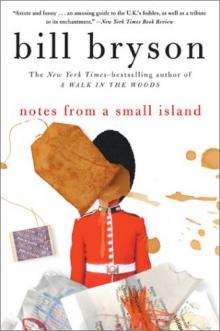 Notes from a Small Island
Notes from a Small Island A Short History of Nearly Everything
A Short History of Nearly Everything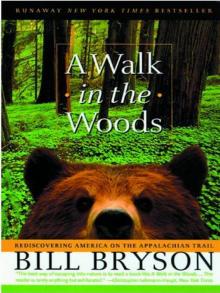 A Walk in the Woods
A Walk in the Woods I'm a Stranger Here Myself
I'm a Stranger Here Myself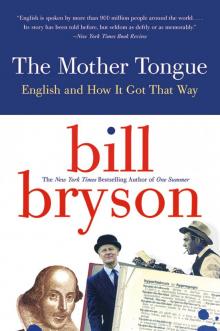 The Mother Tongue
The Mother Tongue Shakespeare
Shakespeare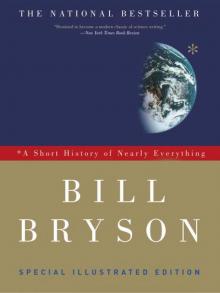 A Short History of Nearly Everything: Special Illustrated Edition
A Short History of Nearly Everything: Special Illustrated Edition The Best American Travel Writing 2016
The Best American Travel Writing 2016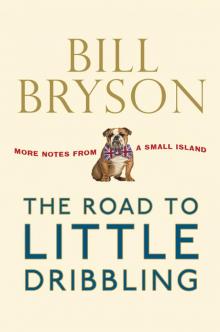 The Road to Little Dribbling
The Road to Little Dribbling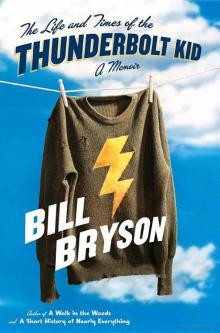 The Life And Times Of The Thunderbolt Kid: A Memoir (v5.0)
The Life And Times Of The Thunderbolt Kid: A Memoir (v5.0)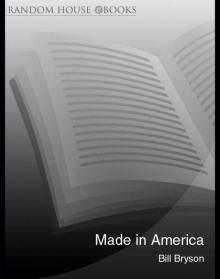 Made In America
Made In America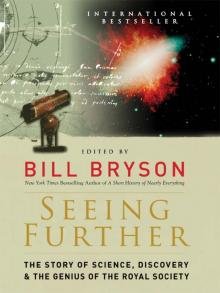 Seeing Further
Seeing Further Shakespeare: The World as Stage
Shakespeare: The World as Stage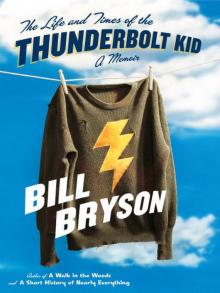 The Life and Times of the Thunderbolt Kid
The Life and Times of the Thunderbolt Kid At Home
At Home Bryson's Dictionary For Writers And Editors (v5.0)
Bryson's Dictionary For Writers And Editors (v5.0) Neither Here Nor There
Neither Here Nor There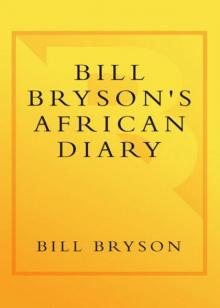 Bill Bryson's African Diary
Bill Bryson's African Diary